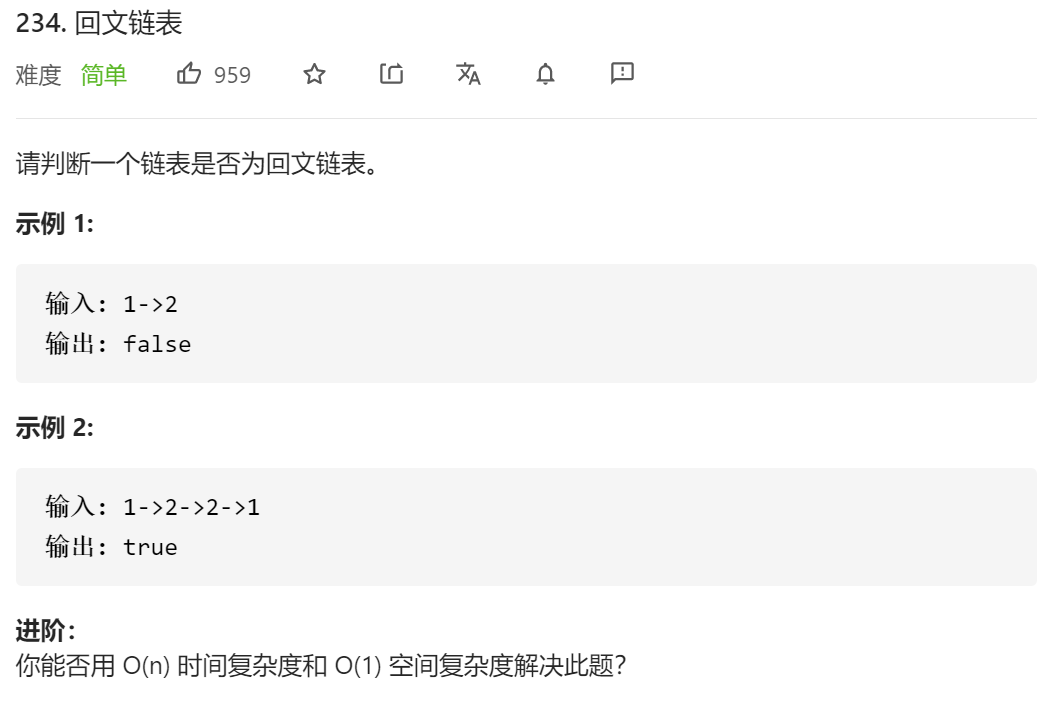
自己的做法
算法思想
可以遍历链表,把元素依次放入数组,然后使用两个指针一前一后来进行判断。但是该算法的时间复杂度是O(n),空间复杂度也是O(n)。不够好。
可以将后半段链表反转,然后和前半段链表比较。然后再恢复为原来的链表(可以不恢复,但~ 恢复回来是个好的习惯)。
- 找到前半段链表的最后一个节点。通过快慢指针方法。
- 反转后半段链表
- 进行比较
- 将链表恢复
找到前半部分链表的尾节点
使用快慢指针法。
通过两个指针slow和fast,开始都指向head。
然后slow向后走一步,fast向后走两步。当fast->next == nullptr || fast->next->next == nullptr时,循环结束。
此时slow指向的就是前半部分链表的尾节点。
反转后半部分链表
之前也做过反转链表的题目,直接使用该算法即可。
使用两个指针cur和pre,初始cur指向head,pre指向null。
然后开始循环:
- 创建局部变量temp = cur->next,来保存下一个节点
- cur指向的结点的next指向pre
- pre = cur
- cur = temp
当 cur == nullptr时,循环结束。
此时pre指向的就是链表反转后的头节点。
算法实现
1
2
3
4
5
6
7
8
9
10
11
12
13
14
15
16
17
18
19
20
21
22
23
24
25
26
27
28
29
30
31
32
33
34
35
36
37
38
39
40
41
42
43
44
45
46
47
48
49
50
51
52
53
54
| class Solution {
public:
static ListNode * reverse(ListNode * head) {
if(head == nullptr || head->next == nullptr) {return head;}
ListNode * cur = head;
ListNode * pre = nullptr;
while (cur != nullptr) {
ListNode * temp = cur->next;
cur->next = pre;
pre = cur;
cur = temp;
}
return pre;
}
static ListNode * endOfFirstList(ListNode * head) {
if(head == nullptr || head->next == nullptr) {return head;}
ListNode * slow = head;
ListNode * fast = head;
while (fast->next != nullptr && fast->next->next != nullptr) {
slow = slow->next;
fast = fast->next->next;
}
return slow;
}
static bool isPalindrome(ListNode* head) {
if(head == nullptr || head->next == nullptr) {return true;}
ListNode * endOfFirst = endOfFirstList(head);
ListNode * startOfSecond = endOfFirst->next;
endOfFirst->next = nullptr;
startOfSecond = reverse(startOfSecond);
ListNode * first = head, * second = startOfSecond;
bool result = true;
while (result && second != nullptr) {
if(first->val != second->val) {
result = false;
}
first = first->next;
second = second->next;
}
startOfSecond = reverse(startOfSecond);
endOfFirst->next = startOfSecond;
return result;
}
};
|
性能分析
时间复杂度:找到前半部分链表的尾结点和反转链表的时间复杂度都是O(n),依次比较时间复杂度也是O(n)。所以总的时间复杂度是O(n)。
空间复杂度:O(1)。
官方做法
官方有三个做法,第一个就是我说的数组法。第三个和我的做法相同,反转链表法。
第二个是递归法。
下面只说递归法。
算法思想
因为单链表只能向后遍历,不能往回遍历。所以可以使用递归,一直递归到尾节点,然后回溯。递归方法外的定义一个变量,初始指向头节点。依次和回溯的进行比较。
算法实现
1
2
3
4
5
6
7
8
9
10
11
12
13
14
15
16
17
18
19
20
21
22
23
| class Solution {
public:
ListNode * front;
bool recursion(ListNode * head) {
if(head != nullptr) {
if(!recursion(head->next)) {
return false;
}
if(head->val != front->val) {
return false;
}
front = front->next;
}
return true;
}
bool isPalindrome(ListNode* head) {
front = head;
return recursion(head);
}
};
|
性能分析
时间复杂度:O(n)。
空间复杂度:在递归调用时,计算机会使用堆栈来存放调用前的数据。因此也是O(n)。
